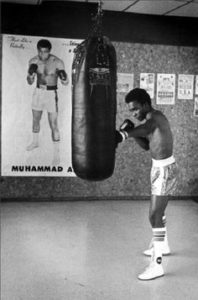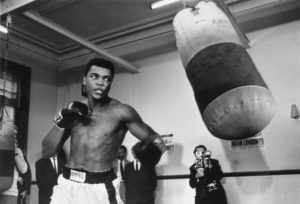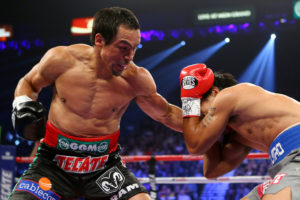Combination Drills For The Heavy Bag

Working the heavy bag is one of the most useful tools you can have in order to build up fighting fitness. However, rather than just focusing on improving your physical fitness, time on the heavy bag is the perfect time to also improve your skills. So many fighters get too used to getting on the heavy bag, and then losing form and technique, getting reckless in an attempt to simply throw hard and furious punches. However, this wastes valuable time that you could be using to improve your skill. Ideally, you want to use the bag to increase endurance by keeping active, but also to improve your skill-set by practising a range of different combinations that you can use in sparring and in a match. We’re going to break down what combinations you should practice, butd even more importantly, why they’re being thrown.
Note: The following combinations are for a orthodox fighter. If you’re southpaw you can obviously still practice them, just reverse left for right, and vice versa.
Basic punch combinations:
– Double jab (1,1) – This includes not only just jabs to the head, but also jabs to both body and head. Bend your knees when going to the body, rather than punching at a downwards angle. Double jabs are good at pushing an opponent back and upsetting their rhythm. Great for buying extra time to set up your own offence.
– Left Jab- Straight Right (1,2) – The most common of all combinations due to the natural instinct to simply throw a left then a right hand. However, there’s more than meets the eye with this punch set up, if you use it smartly. For example, throwing the left slow then the right at a much faster pace makes the right hand much more likely to land, as opposed to if they was thrown at the same pace. This is commonly known as changing the tempo, or breaking rhythm and champions such as Wladamir Klitschko and Floyd Mayweather do this often. This is just one of many ways that this traditional combination can be made to be effective.
– (Double) jab, Straight right (1,1,2) – The purpose of this combination traditionally is to set up the right hand, so the jabs don’t necessarily need as much commitment behind it. The functions of the jabs is to gauge distance, whilst forcing the momentum of your opponent on the back foot, making it hard for him to counter.
– Jab-Straight right-Jab (1,2,1)-The jabs are used as distractions , or testers of range to set up the power shot, and safely leave punching range. Step in with the first jab, land a hard right and step out with the last jab.
– Jab-Straight right-Left hook – (1,2,3); The jab in this combination is much like above, setting up the next two power punches by stepping into a closer range. After throwing the right hand you will have rotated your momentum over to the left side, spring-loading your left side to twist back and unleash a powerful left hook.
– Jab-straight right-left hook-straight right (1,2,3,2) – Much like the above combination, this combination is about continuing the momentum you’ve created after the left hook, as your weight will be shifted onto the right leg after you’ve thrown the left hook, which generates power. The last straight right is also of a different angle than the hook, making it harder to defend against.
– Straight right-left hook-straight right (2,3,2) – The first right doesn’t necessarily require any commitment but if the situation is okay, it can be used as a power punch. It’s function is to get the opponent to put his guard up, exposing his side flank, making way for a left hook. The left hook has the same function but in reverse, causing a fighter to try protect the sides, making way for a straight right.
– These are the most basic of all combinations, but that doesn’t mean they aren’t effective. Some of the most spectacular knockouts in high profile championship fighters were a result of these combinations. Mastery of these combinations are essential and once you understand the motives behind each punch, this alone can put you ahead of fighters who punch with no purpose or thought.

Duran hurt many opponents with the well timed jab-straight combinations
Intermediate combinations
– Left jab-left hook (1,3) – This combination is effective as most fighters are conditioned to expect a right hand after the jab, meaning when done with speed and good accuracy, it can catch many opponents by surprise. A combination frequently used by legendary heavyweight champion Joe Louis.
-Left jab-Left hook-Straight right-left hook (1,3,2,3); Continuing from the above combination, the straight right takes advantage of the opponent in a distorted state as he re-adjusts, especially as the following punches enter at different angles. You can also use the first left hook as a slightly pushing punch to get your opponents head in line for the right hand, but be aware that the right hand will have to be an overhand one, or a cross, otherwise it won’t land accurately.
– Left jab to the body-right straight to the head (7,2) – The jab to the body acts as a disguise for the right to the head, the opponent usually won’t see it coming. Often they’ll respond to the body jab by bringing their guard down which opens up the opportunity to land the right. This is the combination Shane Mosley used to hurt Floyd Mayweather Jr. in the second round.
– Straight right-Left Hook-Right uppercut-Left Hook (2,3,6,3) – The straight and hook combination is a well-known effective partnership. Stepping in with the right hand closes the distance, distracts the opponent and paves the way for a left hook, and right uppercut. Hooks and uppercuts also work good with each-other as they both can be used inside, whilst entering at different angles, which means it’s harder to defend against. The last left hook allows you to shift your momentum and weight backwards and step back out of danger.
– Straight right-left uppercut-left hook-straight right (2,5,3,2) – This combination is particularly useful against a fighter who likes to continuously duck down, especially when the opponent moves down into the uppercut. The uppercut moves the opponents chin up, right into the path of the left hook.
– Jab-straight-jab-straight-left hook-right cross-jab (1,2,1,2,3,2,1) – The first four punches don’t need full commitment but preferably just speed. The function of the punches is to pre-occupy the opponents mind so that you can get the opponent to guard his central area and leave spaces on the sides for hooks. The straight right used as a power punch to use momentum built up from the hook and the jab is used to safely exit punching range with control and authority.

The heavy bag is a great place to practice combinations
Advanced combinations
– Straight right-Left uppercut-Right hook-Left hook – (2,5,4,3) – To get inside, step in when you stick out right hand, and fire a short left uppercut. The
Right uppercut-left hook body-left hook head(6,9.. 6, 3) – This combination can be a very effective combination when done with great timing. At close range, the uppercut can be used to penetrate the guard of your opponent, but even if it doesn’t it will cause your opponents guard to rise and create space on the opponents lower right side so you can land a hand left to the body. Changing levels of attack to the head with the uppercut usually catches a fighter as he drops his guard instinctively after the body hook.
– Left hook, left uppercut, left hook (3,5,3) – The complexity of the combination comes from the fact it’s all off of one hand. Very rarely do you see fighters attempt to throw multiples hook-angle shots on the same hand. It’s usually multiple straights. The uppercut offers a different angle to the hook, making it harder to defend against.
– Straight right-Left body hook-Right uppercut-Left hook-Straight right (2,9,6,2,3,2) – A straight right can be used as a power punch, or a tapping blinder to set up the hook to the body. Moving your momentum over to the right for the uppercut changes your head position.
– Jab-Straight-Right Uppercut-Left body hook- Left head hook (1, 2, 6, 9, 3, 2) – The jab starts things off by distracting the opponent and paving way for a right straight. The uppercut is a punch thrown on the same side as the preceding punch, and this concept alone makes it harder to defend against as people are conditioned to defend against opposing sides. After throwing the right, when you pull it back, use this momentum to then continue winding the punch into position for the uppercut. When firing the hook to the body, use the weight on the front foot to generate power for a left hook.
– Left hook-right hook-left uppercut-right hook-jab (3, 4, 5, 4, 1) – In close, the hooks enter at angles from the outside, so doesn’t need full commitment. The following uppercut and the hook are the punches that you really want to have the most power. The uppercut comes at a different angle of entry and can catch opponents by surprise, and the same concept applies for the right hook, after the uppercut makes the opponent focus on guarding his central region. If he doesn’t, then a right uppercut should do the trick. The ending jab is used to safely exit outside of punching range.
One good habit to get into is using the jab as the last punch of all your combinations while you step out. Floyd Mayweather Sr. teaches all his fighters to end all punches with the jab. It allows you to step out of range with control and it’s definitely the most safest punch in your arsenal. Another alternative is to throw the left hook and pivot around your opponent at the same time to the left, to change the angle and move away.
Of course, there are many more combinations at your disposal and these are just a few that I’ve broken down. I’ll post more articles on combinations involving body punches, using different angles with smart footwork, and using deception & disguise to create/ force openings. The potential combinations available to you are unlimited. The reason I’ve written the function of each combinations is so that you can freely create your own combinations in the ring, because it’s the reason why you are throwing certain punches that is important, rather than what you actually throw. There is no one combination that is better than the other. Certain combinations and punches are just more useful in certain situations.

Juan Manuel Marquez was a master of throwing smart combinations
Final Note – Are They Doing It?
Always have in mind, a champion always does what his opponents neglect to do. Fighters usually punch with no plan and no purpose. However, an elite boxing champion will smartly throw punches to set up the next, and the next, and the next… In order to get ahead of the next fighter, concentrate on manipulating the functions of punches, to string together combinations that unlocks defences.

Leave a Reply
Be the First to Comment!